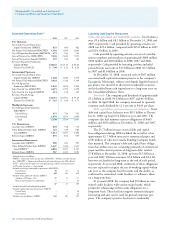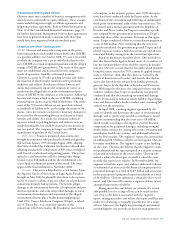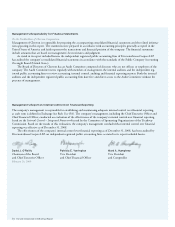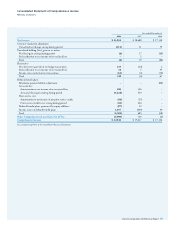Chevron 2008 Annual Report Download - page 54
Download and view the complete annual report
Please find page 54 of the 2008 Chevron annual report below. You can navigate through the pages in the report by either clicking on the pages listed below, or by using the keyword search tool below to find specific information within the annual report.
Management’s Discussion and Analysis of
Financial Condition and Results of Operations
52 Chevron Corporation 2008 Annual Report
dependent upon plan-investment results, changes in pension
obligations, regulatory requirements and other economic
factors. Additional funding may be required if investment
returns are insufficient to offset increases in plan obligations.
For the company’s OPEB plans, expense for 2008 was
$179 million and the total liability, which reflected the
unfunded status of the plans at the end of 2008, was
$2.9 billion.
As an indication of discount rate sensitivity to the deter-
mination of OPEB expense in 2008, a 1 percent increase in
the discount rate for the company’s primary U.S. OPEB plan,
which accounted for about 67 percent of the companywide
OPEB expense, would have decreased OPEB expense by
approximately $20 million. A 0.25 percent increase in the
discount rate for the same plan, which accounted for about
86 percent of the companywide OPEB liabilities, would
have decreased total OPEB liabilities at the end of 2008 by
approximately $56 million.
For the main U.S. postretirement medical plan, the
annual increase to company contributions is limited to 4 per-
cent per year. For active employees and retirees under age 65
whose claims experiences are combined for rating purposes,
the assumed health care cost-trend rates start with 7 percent
in 2009 and gradually drop to 5 percent for 2017 and beyond.
As an indication of the health care cost-trend rate sensitivity
to the determination of OPEB expense in 2008, a 1 percent
increase in the rates for the main U.S. OPEB plan, which
accounted for 86 percent of the companywide OPEB liabili-
ties, would have increased OPEB expense $8 million.
Differences between the various assumptions used to
determine expense and the funded status of each plan and
actual experience are not included in benefit plan costs in
the year the difference occurs. Instead, the differences are
included in actuarial gain/loss and unamortized amounts
have been reflected in “Accumulated other comprehensive
loss” on the Consolidated Balance Sheet. Refer to Note 22,
beginning on page 82, for information on the $6.0 bil-
lion of before-tax actuarial losses recorded by the company
as of December 31, 2008; a description of the method used
to amortize those costs; and an estimate of the costs to be
recognized in expense during 2009.
Impairment of Properties, Plant and Equipment and
Investments in Affiliates The company assesses its proper-
ties, plant and equipment (PP&E) for possible impairment
whenever events or changes in circumstances indicate that
the carrying value of the assets may not be recoverable. Such
indicators include changes in the company’s business plans,
changes in commodity prices and, for crude oil and natural
gas properties, significant downward revisions of estimated
proved-reserve quantities. If the carrying value of an asset
exceeds the future undiscounted cash flows expected from
the asset, an impairment charge is recorded for the excess of
carrying value of the asset over its estimated fair value.
Determination as to whether and how much an asset is
impaired involves management estimates on highly uncertain
matters, such as future commodity prices, the effects of infla-
tion and technology improvements on operating expenses,
production profiles, and the outlook for global or regional
market supply-and-demand conditions for crude oil, natural
gas, commodity chemicals and refined products. How-
ever, the impairment reviews and calculations are based on
assumptions that are consistent with the company’s business
plans and long-term investment decisions.
No major individual impairments of PP&E were
recorded for the three years ending December 31, 2008. An
estimate as to the sensitivity to earnings for these periods if
other assumptions had been used in impairment reviews and
impairment calculations is not practicable, given the broad
range of the company’s PP&E and the number of assump-
tions involved in the estimates. That is, favorable changes to
some assumptions might have avoided the need to impair any
assets in these periods, whereas unfavorable changes might
have caused an additional unknown number of other assets
to become impaired.
Investments in common stock of affiliates that are
accounted for under the equity method, as well as investments
in other securities of these equity investees, are reviewed for
impairment when the fair value of the investment falls below
the company’s carrying value. When such a decline is deemed
to be other than temporary, an impairment charge is recorded
to the income statement for the difference between the invest-
ment’s carrying value and its estimated fair value at the time.
In making the determination as to whether a decline is other
than temporary, the company considers such factors as the
duration and extent of the decline, the investee’s financial per-
formance, and the company’s ability and intention to retain
its investment for a period that will be sufficient to allow for
any anticipated recovery in the investment’s market value.
Differing assumptions could affect whether an investment is
impaired in any period or the amount of the impairment, and
are not subject to sensitivity analysis.
From time to time, the company performs impairment
reviews and determines whether any write-down in the carry-
ing value of an asset or asset group is required. For example,
when significant downward revisions to crude oil and natural
gas reserves are made for any single field or concession, an
impairment review is performed to determine if the carrying
value of the asset remains recoverable. Also, if the expectation
























